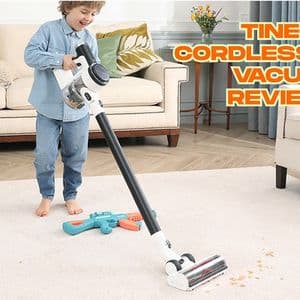What Makes a Vacuum Cleaner Truly Recommended?
A vacuum earns its reputation not from branding alone but from consistent, real-world performance. So what exactly are experts looking for when they endorse a particular model?
Strong Suction Power and Debris Pick-Up
Let’s face it—if a vacuum doesn’t clean well, it doesn’t matter how light or stylish it is. The foundation of any powerful vacuum cleaner lies in its suction power and airflow. Together, these two forces determine how effectively the machine can remove debris from both carpets and hard floors.
Vacuum cleaners with motorized brush rolls often deliver better agitation, loosening embedded dirt for deeper cleaning. For homes with high-pile carpets or pets, this is a non-negotiable feature.
But that’s not all…
Filtration plays a crucial supporting role. HEPA filters capture fine particles, including allergens, ensuring the vacuum doesn’t just move dust around—it removes it from your living space.
Versatility Across Floor Types
A vacuum cleaner recommended for most households should handle multiple flooring types. If your home includes hardwood, tile, rugs, and carpet, look for a vacuum with adjustable height settings or brush roll controls. These allow you to clean without scratching delicate surfaces or losing effectiveness on dense fibers.
Some models even feature automatic floor detection, adjusting suction levels or brush speed accordingly. While this feature is often reserved for premium machines, it streamlines cleaning and reduces manual adjustments.
Here’s why that matters...
Multi-surface compatibility ensures you don’t need to switch tools or purchase separate vacuums for different rooms. It adds to both convenience and long-term value.
Cordless Convenience and Maneuverability
Ever tripped over a cord or struggled to reach under furniture? You’re not alone.
The rise of the cordless stick vacuum addresses these pain points by offering freedom of movement and better storage flexibility. These vacuums are lightweight and typically easier to maneuver than upright or canister models. Battery life has also improved significantly in recent years, with many units delivering up to 40–60 minutes of runtime on a single charge.
Still, cordless models aren’t all created equal.
Battery performance, charging time, and suction consistency should be carefully evaluated. Some vacuums maintain strong suction even as the battery drains, while others drop off quickly. If you have a larger home, look for swappable battery designs or fast-charging options.
Ease of Maintenance and Usability
Here’s the truth most people overlook...
Even the most powerful vacuum loses its edge if filters clog easily or the dustbin is difficult to empty. A vacuum cleaner recommended by experienced users always prioritizes ease of maintenance.
Bagless models with transparent bins allow you to monitor fill levels, while washable filters reduce ongoing costs. Pay attention to how the machine handles hair wrap, especially if you have pets. Many newer models feature tangle-free brush designs that minimize manual cleaning.
Bonus tip: Tools like crevice nozzles, dusting brushes, and upholstery attachments should be easy to store and swap out.
Noise Level and Ergonomics
No one enjoys vacuuming at high decibels. A quieter machine doesn’t just protect your ears—it’s less disruptive to kids, pets, or shared living spaces. Sound ratings around 65–70 decibels are considered quiet, particularly for powerful uprights and sticks.
Also consider the ergonomic design. Look for comfortable handles, intuitive controls, and lightweight construction. The best vacuums reduce strain during long cleaning sessions while still feeling sturdy and effective.
Remember this: If it’s hard to carry, you’ll avoid using it.
Budget vs. Performance: Striking the Right Balance
This is where many shoppers get stuck...
They assume higher price always means better cleaning. While that can be true for certain advanced features, many budget-friendly vacuums perform admirably for everyday tasks. The best budget vacuum cleaner typically delivers solid suction, reliable filtration, and easy handling—without bells and whistles that drive up the cost.
The trick is in knowing what to prioritize.
If you don’t need smart sensors, LED displays, or app connectivity, you can often save a substantial amount. Focus on essentials like motor strength, build quality, and warranty support. Durability matters just as much as first impressions.
Choosing the Right Type for Your Home
Still not sure which direction to go? Here’s a quick breakdown of vacuum types and their strengths:
Upright Vacuums
-
Ideal for large areas with carpet
-
Strong suction and wide cleaning paths
-
Often heavier but more powerful
Canister Vacuums
-
Excellent for mixed surfaces and stairs
-
Easy to maneuver under furniture
-
Usually quieter with better airflow control
Stick Vacuums
-
Lightweight and cordless options available
-
Great for quick clean-ups and small homes
-
Less powerful but highly convenient
Handheld Vacuums
-
Best for spot cleaning, upholstery, and vehicles
-
Cordless and compact
-
Limited capacity and suction
Each type has trade-offs. Your floor plan, storage space, and lifestyle will guide your final choice.
Final Thoughts
So, what should you take away from all this?
A vacuum cleaner recommended by experts typically offers a strong combination of suction power, multi-surface versatility, and easy usability. Whether you’re drawn to the mobility of a cordless stick vacuum, the raw strength of an upright, or the value offered by the best budget vacuum cleaner, what matters most is alignment with your actual cleaning habits.
Don’t fall for flashy features that sound great on paper but offer little in practical benefit. Instead, focus on reliability, design, and long-term satisfaction.
The right vacuum isn’t just a cleaning tool—it’s an upgrade to your daily routine.





















